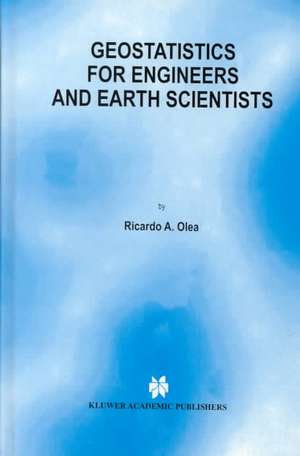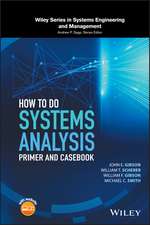Geostatistics for Engineers and Earth Scientists
Autor Ricardo a. Oleaen Limba Engleză Hardback – 30 mai 1999
| Toate formatele și edițiile | Preț | Express |
|---|---|---|
| Paperback (1) | 945.79 lei 6-8 săpt. | |
| Springer Us – 21 dec 2012 | 945.79 lei 6-8 săpt. | |
| Hardback (1) | 952.40 lei 6-8 săpt. | |
| Springer Us – 30 mai 1999 | 952.40 lei 6-8 săpt. |
Preț: 952.40 lei
Preț vechi: 1161.47 lei
-18% Nou
Puncte Express: 1429
Preț estimativ în valută:
182.26€ • 197.91$ • 153.10£
182.26€ • 197.91$ • 153.10£
Carte tipărită la comandă
Livrare economică 23 aprilie-07 mai
Preluare comenzi: 021 569.72.76
Specificații
ISBN-13: 9780792385233
ISBN-10: 0792385233
Pagini: 303
Ilustrații: XVII, 303 p.
Dimensiuni: 155 x 235 x 23 mm
Greutate: 0.64 kg
Ediția:1999
Editura: Springer Us
Colecția Springer
Locul publicării:New York, NY, United States
ISBN-10: 0792385233
Pagini: 303
Ilustrații: XVII, 303 p.
Dimensiuni: 155 x 235 x 23 mm
Greutate: 0.64 kg
Ediția:1999
Editura: Springer Us
Colecția Springer
Locul publicării:New York, NY, United States
Public țintă
ResearchDescriere
Engineers and earth scientists are increasingly interested in quantitative methods for the analysis, interpretation, and modeling of data that imperfectly describe natural processes or attributes measured at geographical locations. Inference from imperfect knowledge is the realm of classical statistics. In the case of many natural phenomena, auto- and cross- correlation preclude the use of classical statistics. The appropriate choice in such circumstances is geostatistics, a collection of numerical techniques for the characterization of spatial attributes similar to the treatment in time series analysis of auto-correlated temporal data. As in time series analysis, most geostatistical techniques employ random variables to model the uncertainty that goes with the assessments. The applicability of the methods is not limited by the physical nature of the attributes.
Geostatistics for Engineers and Earth Scientists presents a concise introduction to geostatistics with an emphasis on detailed explanations of methods that are parsimonious, nonredundant, and through the test of time have proved to work satisfactorily for a variety of attributes and sampling schemes. Most of these methods are various forms of kriging and stochastic simulation. The presentation follows a modular approach making each chapter as self-contained as possible, thereby allowing for reading of individual chapters, reducing excessive cross-referencing to previous results and offering possibilities for reviewing similar derivations under slightly different circumstances. Guidelines and rules are offered wherever possible to help choose from among alternative methods and to select parameters, thus relieving the user from making subjective calls based on an experience that has yet to be acquired.
Geostatistics for Engineers and Earth Scientists is intended to assist in the formal teaching of geostatistics or as a self tutorial for anybody who is motivated to employ geostatistics for sampling design, data analysis, or natural resource characterization. Real data sets are used to illustrate the application of the methodology.
Geostatistics for Engineers and Earth Scientists presents a concise introduction to geostatistics with an emphasis on detailed explanations of methods that are parsimonious, nonredundant, and through the test of time have proved to work satisfactorily for a variety of attributes and sampling schemes. Most of these methods are various forms of kriging and stochastic simulation. The presentation follows a modular approach making each chapter as self-contained as possible, thereby allowing for reading of individual chapters, reducing excessive cross-referencing to previous results and offering possibilities for reviewing similar derivations under slightly different circumstances. Guidelines and rules are offered wherever possible to help choose from among alternative methods and to select parameters, thus relieving the user from making subjective calls based on an experience that has yet to be acquired.
Geostatistics for Engineers and Earth Scientists is intended to assist in the formal teaching of geostatistics or as a self tutorial for anybody who is motivated to employ geostatistics for sampling design, data analysis, or natural resource characterization. Real data sets are used to illustrate the application of the methodology.
Cuprins
List of Mathematical Definitions. List of Theorems. List of Corollaries. List of Lemmas. Preface. 1. Introduction. 2. Simple Kriging. 3. Normalization. 4. Ordinary Kriging. 5. The Semivariogram. 6. Universal Kriging. 7. Crossvalidation. 8. Drift and Residuals. 9. Stochastic Simulation. 10. Reliability. 11. Cumulative Distribution Estimators. 12. Block Kriging. 13. Ordinary Cokriging. 14. Regionalized Classification. References. Appendices: A. West Lyons Field Sampling. B. High Plains Aquifer Sampling. C. UNCF Sampling. D. Dakota Aquifer Sampling. Author Index. Subject Index.
Recenzii
`This book ... is one of the best introductions to geostatistics. It is a perfect balance between theory and methodological considerations. ... Even the more experienced geostatisticians will read it with great pleasure and will find for it a very special place on their bookshelf. It is the kind of book that you enjoy recommending to anyone who wants a good starting point in a field. ... I very stronly recommend this book to anyone who wants to have an introductive, consistent and unbiased view of geostatistics, a discipline that urgently needs young and enthusiastic scientists with a fresh view of the problems. In this sense, this book should help us a lot, at least as much as it will help them.'
P. Bogaert in Stochastic Environmental Research and Risk Assessment, 14 (2000)
'This book should be seriously considered for adoption in a graduate level course on geostatistics. Moreover, this book would make a valuable addition to any library on spatial analysis.'
Mathematical Geology, July (2002)
P. Bogaert in Stochastic Environmental Research and Risk Assessment, 14 (2000)
'This book should be seriously considered for adoption in a graduate level course on geostatistics. Moreover, this book would make a valuable addition to any library on spatial analysis.'
Mathematical Geology, July (2002)








